TAKING IT TO THE MAX
Page 40
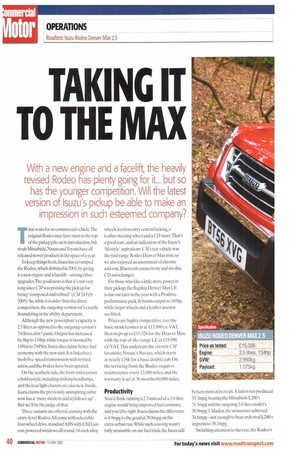
Page 41
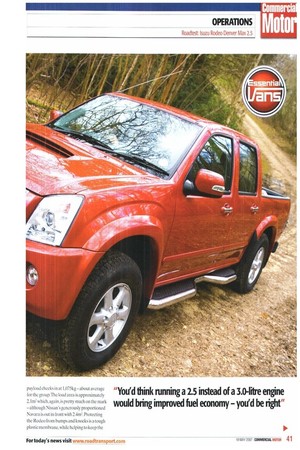
Page 42
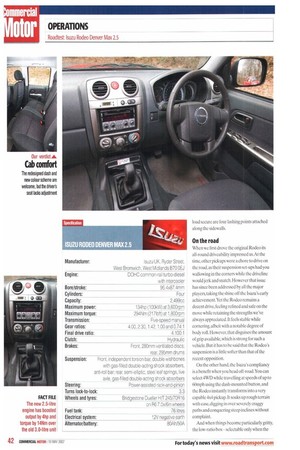
Page 43
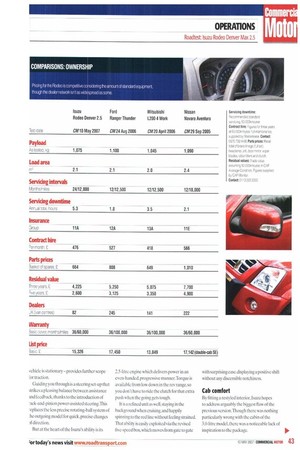
Page 44
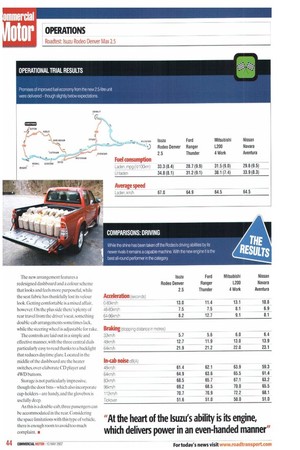
If you've noticed an error in this article please click here to report it so we can fix it.
With a new engine and a facelift, the heavily
revised Rodeo has plenty going for it.. but so has the younger competition. Will the latest version of Isuzuis pickup be able to make an impression in such esteemed company?
Time waits for no commercial vehicle.The original Rodeo may have risen to the top of the pickup pile on its introduction, but rivals Mitsubishi,NissanandToyota have all released newer products in the space of a year.
To keep things fresh, Isuzu has revamped the Rodeo, which debuted in 2003, by giving it a new engine and a facelift— among other upgrades.The good news is that it's not very long since CM was praising the pickup for being"composed and refined"(CM 24 Feb 2005). So, while it is older than the direct competition, the outgoing version isn't exactly floundering in the ability department.
Although the new powerplant's capacity is 2.5 litres as opposed to the outgoing version's 3.0 litres, don't panic. Output has increased by 4hp to 134hp, while torque is boosted by 14Nm to 294Nm.Isuzu also claims better fuel economy with the new unit. It is linked to a fresh five-speed transmission with revised ratios, and the brakes have been uprated.
On the aesthetic side, the front end receives a bold restyle, including striking headlamps, and the rear light clusters are also new. Inside, Isuzu claims the previously uninspiring cabin now has a "more modern and stylish set-up". But we'll be the judge of that.
Three variants are offered, starting with the entry-level Rodeo. All come with selectable four-wheel drive, standard ABS with EBD, aircon, powered windows all round,16-inch alloy wheels, keyless entry central locking, a leather steering wheel and a CD tuner.That's a good start and an indication of the Isuzu's lifestyle' aspirations. CM 's test vehicle was the mid-range Rodeo Denver Max trim,so we also enjoyed an assortment of chrome add-ons,Bluetooth connectivity and six-disc CD autochanger.
For those who like a little more power in their pickup, the flagship Denver Max LE is due out later in the year with a Prodrive performance pack. It boosts output to 165hp, while larger wheels and a leather interior are fitted.
Prices are highly competitive. too; the basic model comes in at £13,990 ex-VAT, then steps up to £15,326 for the Denver Max, with the top-of-the-range LE at £19,990 ex-VAT. This undercuts the current CM favourite, Nissan's Navara, which starts at nearly 1 6k for a basic double cab. On the servicing front the Rodeo requires maintenance every 12,000 miles, and the warranty is set at 36 months/60,000 miles.
Productivity You'd think running a 2.5 instead of a 3.0-litre engine would bring improved fuel economy, and you'd be right: Isuzu claims the difference is 4.9mpg to the good at 39.8mpg on the extra-urban run. While such a saving wasn't fully attainable on our fuel trials, the Isuzu still betters most of its rivals. A laden run produced 33.3mpg, beating the Mitsubishi L200's 31.5mpg and the outgoing 3.0-litre model's 30.9mpg. Unladen, the newcomer achieved 34.8mpg— not enough to beat arch rival L200's impressive-38.1mpg.
Switching attention to the rear, the Rodeo's payload checks in at 1,075kgabout average for the group.The load area is approximately 2.1m2 which, again, is pretty much on the mark although Nissan's generously proportioned Navara is out in front with 2.4m2. Protecting the Rodeo from bumps and knocks is a tough plastic membrane, while helping to keep the load secure are four lashing points attached along the sidewalls.
On the road When we first drove the original Rodeo its all-round driveability impressed us. At the time, other pickups were a chore to drive on the road, as their suspension set-ups had you wallowing in the corners while the driveline would jerk and snatch. However that issue has since been addressed by all the major players, taking the shine off the Isuzu's early achievement. Yet the Rodeo remains a decent drive, feeling refined and safe on the move while retaining the strengths we've always appreciated. It feels stable while cornering, albeit with a notable degree of body roll. However, that disguises the amount of grip available, which is strong for such a vehicle. But it has to be said that the Rodeo's suspension is a little softer than that of the recent opposition.
On the other hand. the Isuzu's compliancy is a benefit when you head off-road. You can select 4WD while travelling at speeds of up to fiOmph using the dash-mounted button, and the Rodeo instantly transforms into a very capable 4x4 pickup. It soaks up rough terrain with ease, digging in over severely craggy paths and conquering steep inclines without complaint.
And when things become particularly gritty, the low-ratio box —selectable only when the vehicle is stationary—provides further scope or traction.
Guiding you through is a steering set-up that arikes a pleasing balance between assistance and feedback, thanks to the introduction of ack-and-pinion power-assisted steering.This -eplaces the less precise rotating-ball system of :he outgoing model for quick, precise changes direction.
But at the heart of the Isuzu's ability is its 2.5-litre engine which delivers power in an even-handed, progressive manner.Torque is available from low down in the rev range. so you don't have to ride the clutch for that extra push when the going gets tough.
It is a refined unit as welLstaying in the background when cruising, and happily spinning to the red line without feeling strained. That ability is easily exploited via the revised five-speed box, which moves from gate to gate with surprising ease. displaying a positive shift without any discernible notchiness.
Cab comfort
By fitting a restyled interior, lsuzu hopes to address arguably the biggest flaw of the previous version.Though there was nothing particularly wrong with the cabin of the 3.0-litre model, there was a noticeable lack of inspiration to the package. The new arrangement features a redesigned dashboard and a colour scheme that looks and feels more purposeful, while the seat fabric has thankfully lost its velour look. Getting comfortable is a mixed affair, however. On the plus side there's plenty of rear travel from the driver's seat, something double-cab arrangements sometimes lack, while the steering wheel is adjustable for rake.
The controls are laid out in a simple and effective manner, with the three central dials particularly easy to read thanks to a backlight that reduces daytime glare. Located in the middle of the dashboard are the heater switches, over-elaborate CD player and 4WD buttons.
Storage is not particularly impressive, though the door binswhich also incorporate cup-holders -are handy, and the glove box is usefully deep.
As this is a double-cab, three passengers can be accommodated in the rear. Considering the space limitations with this type of vehicle, there is enough room to avoid too much complaint.






















































































































































































